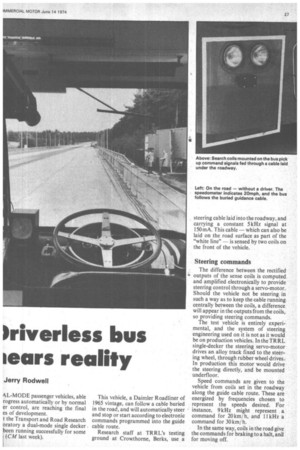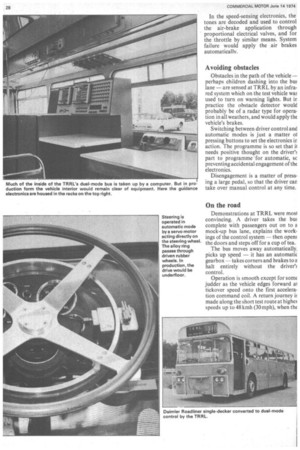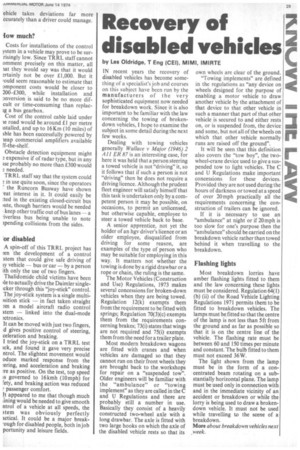)riverless bus 'ears reality
Page 29

Page 30

Page 31

If you've noticed an error in this article please click here to report it so we can fix it.
Jerry Rodwell
AL-MODE passenger vehicles, able rogress automatically or by normal er control, are reaching the final es of development.
t the Transport and Road Research oratory a dual-mode single decker been running successfully for some (CM last week). This vehicle, a Daimler R oadliner of 1965 vintage, can follow a cable buried in the road, and will automatically steer and stop or start according to electronic commands programmed into the guide cable route.
Research staff at TR R Us testing ground at Crowthorne, Berks, use a steering cable laid into the roadway, and carrying a constant 5 kHz signal at 150 mA. This cable which can also be laid on the road surface as part of the "white line" — is sensed by two coils on the front of the vehicle.
Steering commands
The difference between the rectified outputs of the sense coils is computed and amplified electronically to provide steering control through a servo-motor. Should the vehicle not be steering in such a way as to keep the cable running centrally between the coils, a difference will appear in the outputs from the coils, so providing steering commands.
The test vehicle is entirely experimental, and the system of steering engineering used on it is not as it would be on production vehicles. In the TRRL single-decker the steering servo-motor drives an alloy track fixed to the steering wheel, through rubber wheel drives. In production this motor would drive the steering directly, and be mounted underfloor.
Speed commands are given to the vehicle from coils set in the roadway along the guide cable route. These are energized by frequencies chosen to represent the speeds desired. For instance, 9 kHz might represent a command for 20 km/ h, and 11 kHz a command for 30 km/ h.
In the same way, coils in the road give the commands for braking to a halt, and for moving off. In the speed-sensing electronics, the tones are decoded and used to control the air-brake application through proportional electrical valves, and for the throttle by similar means. System failure would apply the air brakes automatically.
Avoiding obstacles
Obstacles in the path of the vehicle — perhaps children dashing into the but lane — are sensed at TR R L by an infrared system which on the test vehicle was used to turn on warning lights. But in practice the obstacle detector would probably be of a radar type for operation in all weathers, and would apply the vehicle's brakes.
Switching between driver control and automatic modes is just a matter oi pressing buttons to set the electronics in action. The programme is so set that ii needs positive thought on the driver's part to programme for automatic, sc preventing accidental engagement of the electronics.
Disengagement is a matter of pressing a large pedal, so that the driver can take over manual control at any time.
On the road
Demonstrations at TRRL were mosl convincing. A driver takes the but complete with passengers out on to a mock-up bus lane, explains the work ings of the control system then opens the doors and steps off for a cup of tea. The bus moves away automatically, picks up speed — it has an automatic gearbox takes corners and brakes to a halt entirely without the driver's control.
Operation is smooth except for some judder as the vehicle edges forward al tickover speed onto the first accelera• tion command coil. A return journey is made along the short test route at highet speeds up to 48 kmh (30mph), when the chicle takes deviations far more ccurately than a driver could manage.
low much?
Costs for installations of the control ystem in a vehicle may prove to be surrisingly low. Since TRRL staff cannot omment precisely on this matter, all 'tat they would say was that it would ..rtainly not be over £1,000. But it ,ould seem reasonable to estimate that 3mponent costs would be closer to 2004300, while installation and mversion is said to be no more difcult or time-consuming than replacig a bus gearbox.
Cost of the control cable laid under le road would be around £1 per metre istalled, and up to 16 Km (10 miles) of ible has been successfully powered by -leap commercial amplifiers available If-the-shelf.
Obstacle detection equipment might expensive if of radar type, but in any Ise probably no more than £300 would needed.
TRRL staff say that the system could in use quite soon, since the operators ' the Runcorn Busway have shown -eat interest in it. It could easily be Lted in the existing closed-circuit bus lute, though barriers would be needed keep other traffic out of bus lanes — a iverless bus being unable to note Tending collisions from the sides.
or disabled
A spin-off of this TRRL project has :en the development of a control stem that could give safe driving of iy vehicle — bus or car — by a person ith only the use of two fingers. Thalidomide child victims have been Ile to actually drive the Daimler single!cker through this "joy-stick" control. The joy-stick system is a single multi)sition stick — in fact taken straight 3m a model aircraft radio control stem — linked into the dual-mode !ctronics, It can be moved with just two fingers, d gives positive control of steering, celeration and braking.
I tried the joy-stick on a TRRL test ick, and found it gave very precise ntrol. The slightest movement would oduce marked response from the :ering, and acceleration and braking !re as positive. On the test, top speed is governed to 16 kmh (10mph) for Fety, and braking action was reduced passenger comfort.
It appeared to me that though much Ailing would be needed to give smooth ntrol of a vehicle at all speeds, the stem was obviously perfectly ictical. It could be a major break.ough for disabled people, both in job portunity and leisure fields.




























































































































